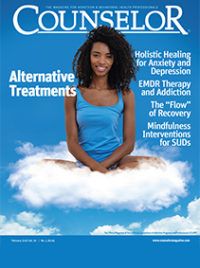Share
 As a wellness advocate, I embrace a strong commitment to encouraging people to enhance both their quantitative level of health and well-being, and the qualitative dimensions of their lives, through actively pursuing a wellness-oriented lifestyle. As recent events have made me painfully aware of the potential devastating impact of a stroke on our overall level of health and well-being, I have chosen to focus this column on the important topic of stroke prevention. This column is particularly relevant to both practicing and recovering alcoholics and addicts, as uncontrolled ingestion of toxic substances can substantially increase our vulnerability to circulatory disorders.
As a wellness advocate, I embrace a strong commitment to encouraging people to enhance both their quantitative level of health and well-being, and the qualitative dimensions of their lives, through actively pursuing a wellness-oriented lifestyle. As recent events have made me painfully aware of the potential devastating impact of a stroke on our overall level of health and well-being, I have chosen to focus this column on the important topic of stroke prevention. This column is particularly relevant to both practicing and recovering alcoholics and addicts, as uncontrolled ingestion of toxic substances can substantially increase our vulnerability to circulatory disorders.
The Nature of the Beast
Paraphrasing from the National Stroke Association, a stroke is a “brain attack” that occurs “when blood flow to an area of the brain is cut off” (2018). When that happens, brain cells are deprived of oxygen and begin to die. When brain cells die during a stroke, abilities controlled by that area of the brain, such as memory and muscle control, can be seriously damaged.
Unquestionably, our nation’s epidemic of strokes or cerebrovascular accidents (CVAs) constitutes a major public health problem. Stroke is the fifth leading cause of death and the leading cause of adult disability, and every year nearly 800,000 Americans experience a new or recurrent stroke (National Stroke Association, 2018). The good news is that up to 80 percent of strokes can be prevented.
Family Ties
Over the past two years I have witnessed the devastating impact of strokes on two members of my immediate family. Two years ago my youngest brother, seven years my junior, suffered a major stroke. One year after that he experienced a second stroke, which took the form of a cerebral hemorrhage. He has also undergone vascular surgery to clear a carotid artery that was almost completely blocked. Fortunately my bother is highly intelligent and often able to draw upon his sense of humor to help him cope. He is confined to a nursing home and has experienced serious muscular atrophy, combined with stroke-related depression. On good days he is both lucid and upbeat, which is a welcome relief from the sense of despair he often experiences.
Additionally, one year ago my wife’s sister, a pleasant woman in her mid-eighties, suffered a debilitating stroke. She currently experiences stroke-related expressional aphasia, a speech impediment that makes it very difficult for her to communicate. Simply put, when conversing with someone she is aware of what she wants to say, but experiences great difficulty in finding the right words. While she is severely impaired, to date her son and his wife have been able to maintain her in her own home in California with the support of home health services and frequent doctors’ visits.
Cornerstones of Stroke Prevention
In general terms, stroke prevention includes attempting to follow a wellness-oriented lifestyle incorporating sound nutrition, regular exercise, and a positive outlook toward life and our relations with others. Other key components include effectively managing day-to-day stresses and taking proactive steps to avoid chronic stress overload while focusing on leading a life of purpose that resonates with our core beliefs and values (Newport, 2004).
With specific regard to stroke prevention, we must identify and manage the associated risk factors. Keep in mind that experts state 80 percent of all strokes are preventable. The American Stroke Association (2019) identifies associated risk factors as the following:
- Family history of stroke
- Presence of diabetes
- High-fat diet, often accompanied by obesity
- Variety of cardiac risk factors including elevated blood pressure, high blood cholesterol, atrial fibrillation (a heart rhythm disorder), and carotid artery disease
- Lack of adequate sleep
- Alcohol abuse
- Smoking
A family history of stroke emphasizes the need for special precautions regarding all other risk factors. The presence of diabetes is associated with significantly elevated risk of both heart disease and stroke, and requires careful monitoring of diet. A high-fat diet, accompanied by excessive body weight and a sedentary lifestyle, dramatically increases the risk of both heart disease and stroke. Consistently elevated blood pressure (BP) is a precursor of stroke, which underscores the need for regular BP monitoring and treatment when medically indicated. Fortunately a regimen including a heart-healthy diet, regular vigorous exercise, and avoiding chronic stress overload can go a long way toward normalizing blood pressure. Presence of atrial fibrillation is associated with a significantly elevated risk of stroke and requires ongoing monitoring and treatment.
The level of plaque build-up in our carotid arteries is a significant marker concerning our overall risk of stroke, as a piece of plaque can cause a stroke by breaking off and traveling to the brain. A carotid artery scan is an easy to perform and painless procedure that provides invaluable information concerning our relative risk of stroke, together with appropriate preventative measures. While I am not a physician, I strongly advocate that everyone over the age of fifty-five should undergo a baseline carotid scan. Inadequate sleep, often associated with “burning the candle at both ends” and/or excessive stress overload, also elevates our risk of stroke.
If your counseling practice entails considerable involvement with practicing or recovering alcoholics/addicts, pay particular attention to those clients who are smokers. Unfortunately, a large percentage of alcoholics and drug abusers carry their nicotine addiction into recovery, and it is well known that smoking substantially elevates the risks of both heart disease and stroke. Fortunately all states now make available highly skilled, free-of-charge telephone counseling to smokers who want to quit. Your clients can access the quitline serving their state by dialing 1-800-QUIT-NOW.
Before ending this section on stroke prevention, I want to highlight key warning signs of a stroke, which indicate the need to immediately call 911! These are summarized by the acronym “FAST”:
- “F”: face drooping
- “A”: arm weakness
- “S”: speech difficulty (e.g., inability to talk, slurred speech, or talking incoherently)
- “T”: time (i.e., observers should immediately call 911)
Further details concerning these warning signs are available online at the American Stroke Association website: www.strokeassociation.org.
Life after Stroke
In reference to striving for intact survival, followed by maximizing the survivor’s quality of life, it is imperative to keep in mind two critically important maxims:
- When a stroke occurs we need to minimize potential damage by immediately calling 911.
- Our prospects for enjoying high quality of life following a stroke are directly related to our overall quality of health before the stroke.
Stroke treatment and recovery entails acute hospital stabilization, often followed by an intensive course of inpatient rehabilitation, which in turn is followed by postdischarge home health services and support focusing on patients, their families, and other loved ones. Nursing home placement may be necessary for patients who cannot be effectively cared for at home. In that event, frequent visits by loved ones and careful monitoring of care are highly recommended.
The stroke recovery process poses major challenges for patients and their families. Poststroke depression is common, as is sinking into a despondent state of resignation. Full advantage should be taken of community-based sources of support, particularly professionally facilitated support groups for stroke survivors and their families.
As early in recovery as feasible, I strongly encourage stroke patients to befriend a stroke survivor who has attained a high level of motivation and functionality. Hopefully that person will be willing to serve as a “cheerleader” to help patients maintain their motivation when the going gets rough.
Countless numbers of motivated stroke survivors ultimately attain high levels of both life satisfaction and functionality. The name Ram Dass, one of my favorite “gurus,” immediately comes to mind. Two decades ago Ram Dass, in denial concerning his elevated blood pressure, suffered a major stroke in his early sixties (Dass, 2001; Dass & Bush, 2018). While his early stages of recovery were fraught with considerable anguish and despair, now he has attained a high level of functionality and zest for life.
Closer to home, several years ago my wife and I attended a church presided over a priest who was a stroke survivor. He was very motivational in presiding over the Sunday services. While at times he might momentarily falter, I found that he possessed a very warm and open heart. To me, whatever slight deficiencies he occasionally experienced in verbal expression were more than adequately compensated for by his open, loving heart. That quality, I suspect, was very likely attributable, at least in part, to his experiencing and surviving a major stroke.
In closing, I hope this column has been informative concerning the importance of stroke prevention, both for yourself and your clients. I encourage you to share this column to anyone who might benefit from the message. Until next time—to your health!
References
American Stroke Association (ASA). (2019). Stroke risk factors. Retrieved from https://www.strokeassociation.org/en/about-stroke/stroke-risk-factors
Dass, R. (2001). Still here: Embracing aging, changing, and dying. New York, NY: Riverhead Books.
Dass, R., & Bush, M. (2018). Walking each other home: Conversations on loving and dying. Boulder, CO: Sounds True.
National Stroke Association. (2018). What is stroke? Retrieved from https://www.stroke.org/understand-stroke/what-is-stroke/
Newport, J. (2004). The wellness-recovery connection: Charting your pathway to optimal health while recovering from alcoholism and drug addiction. Deerfield Beach, FL: Health Communications.
About Me
John Newport, PhD, is an addiction specialist, writer, and speaker living in Tucson, Arizona. He is the author of The Wellness-Recovery Connection: Charting Your Pathway to Optimal Health While Recovering from Alcoholism and Drug Addiction (2004). He is available for workshops, conference presentations, and staff trainings on all aspects of wellness and recovery, as well as for personal wellness and recovery coaching by phone. He can be reached at healingtucson@hotmail.com.














 Counselor Magazine is the official publication of the California Association of Addiction Programs and Professionals (CCAPP). Counselor offers online continuing education, article archives, subscription deals, and article submission guidelines. It has been serving the addiction field for more than thirty years.
Counselor Magazine is the official publication of the California Association of Addiction Programs and Professionals (CCAPP). Counselor offers online continuing education, article archives, subscription deals, and article submission guidelines. It has been serving the addiction field for more than thirty years.